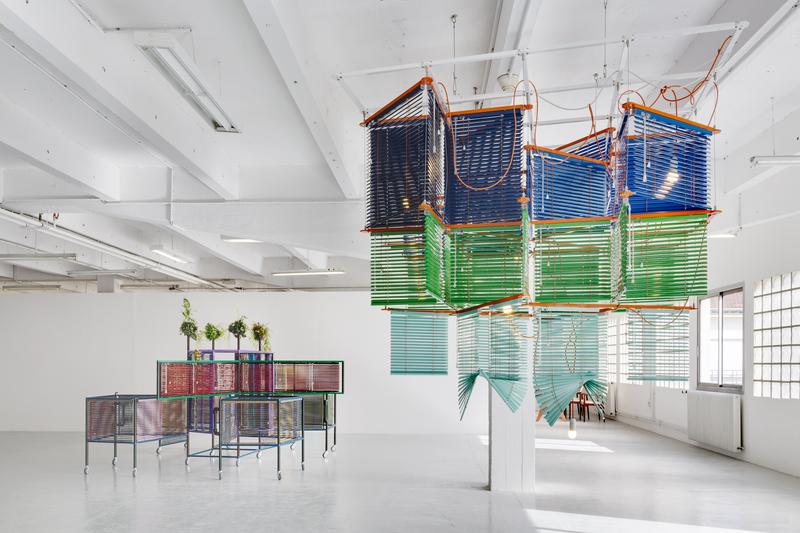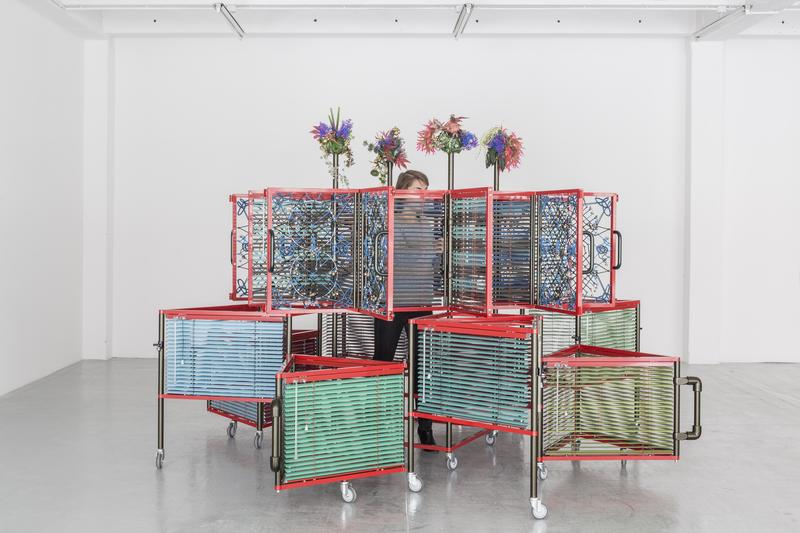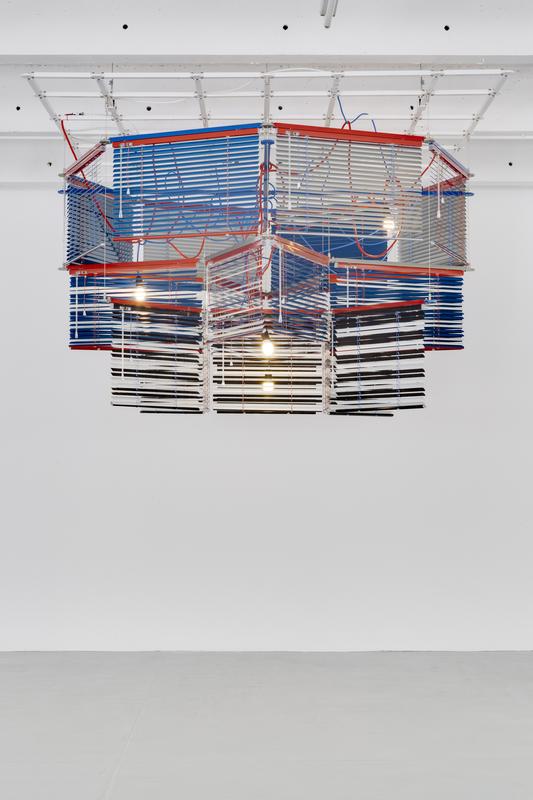Haegue Yang presents a body of sculptural works at Chantal Crousel that are a must see if your in Paris. Yang names 3 of the works on view “Chandelier”, which hang stoically in the gallery space created with complex arrangements of colorfully painted blinds, with power lines loosely draped ending with bright lightbulbs that shine brightly through the open spaces between each blind. There are moments of disorder in one chandelier, where the blinds fold on themselves creating a new discourse in the horizontal orientation of the blinds that float in the gallery space. It is moments like these that make polished work more approachable, and softens the cold, hard edge that is present in high production work like Yang’s. The imploding blinds are only seen in one of the works, but stands out as a triumph in the work that Yang exhibits in “Ajar”.

Haegue Yang, "Ajar", Exhibition view. Photo credits: Florian Kleinefenn. Courtesy de l'artiste et Galerie Chantal Crousel, Paris
There are also two other works, Dress Vehicles, that Yang exhibits. These are modular works where the viewer is encouraged to interact with the sculpture by standing inside the work and direct and push the piece whichever way your heart desires. These works are reminiscent of dressing rooms, and the blinds serve as an optional shield from peering eyes. Small bouquets of artificial flowers stand tall above the sculptures, surpassing the slick industrial materials that structure the pieces existence. These bouquets are a key element to the piece by crowning the sculptures with a more playful remark made by Yang. Without these flower arrangements the sculptures would not seen as inviting, altering the experience that participants have with the work. What makes this participatory work different from others is that Yang’s determination of using polished materials like powder coated steel and venetian blinds. The chandeliers are made form the same materials but are lifted high within the space where a looming sense of “untouchable” is present. But surpassing that, Yang made 2 pieces with the same materials but allow visitors to steer the work whichever way they please. Their is also a great deal of trust in the viewer to steer a piece with such high production value. It must be difficult for gallerists to watch people interact with the work, hoping that nobody will run it strait into a wall just for kicks. Yang exhibits much freedom in the way he works with his carefully selected pallet of industrial materials, allowing small pathways of playfulness to be opened in work that can seem unapproachable.
–
Contributed by Gregory Ito

Haegue Yang, Dress Vehicle - Yin Yang. 2012. Aluminum Venetian blinds, powder-coated aluminum frame, magnets, bells, plastic plants, rubber ropes, casters. 318 cm ⌀ 310.00 cm | 125 3/16 inches ⌀ 122 1/16 inches

Haegue Yang, Clowny Yin Yang. 2012. Aluminum Venetian blinds, powder-coated aluminum frame, electric cables, light bulbs. 125.80 cm ⌀ 218.50 cm | 495 4/16 inches ⌀ 860 4/16 inches
Artist: Haegue Yang
Exhibition Title: Ajar
Venue: Chantal Crousel, Paris
Exhibition Dates: October 18 – December 7, 2012
Website: http://www.crousel.com/home/exhibition/343/
Press Release Excerpt:
The exhibition, titled Ajar, is solely composed of sculptural pieces: three of them are nicknamed by the artist Chandeliers, and two mobile sculptures are categorized by the artist as Dress Vehicles. Both categories of the sculptures equally center around the primary material of the sculpture, Venetian blinds, suggesting its ambivalent nature of obscuring or allowing our vision.
The Chandeliers are ceiling-mounted sculptures made of industrially manufactured, but customized Venetian blinds and powder-coated aluminum frames. Electric cables with light bulbs are draped over the frame, reinforcing the otherwise oblique distinction between the internal and the external of the sculptures. Several layers of complex assemblies are combined to mirror geometric patterns based on grid, such as a tangram.
The two newly-produced Dress Vehicles are also composed of Venetian blinds. They are layered grid and transformable. These sculptures, designed to be performed by someone, function like a baby walker. From inside, a person can walk forward or backward with it or rotate it. The vehicles, mounted on casters, extend and accommodate the body and enable us to choreograph a limited yet stylized movement in space. Partly inspired by the ritualistic Sacred Dances of the Russian spiritualist Georges I. Gurdjieff and the Triadic Ballet (1922) of Oscar Schlemmer, the two Dress Vehicles presented at La Douane are slightly modified versions of those Haegue Yang presented with sound and light display in the frame of Art in Action at The Tanks at the Tate Modern, London this year.


